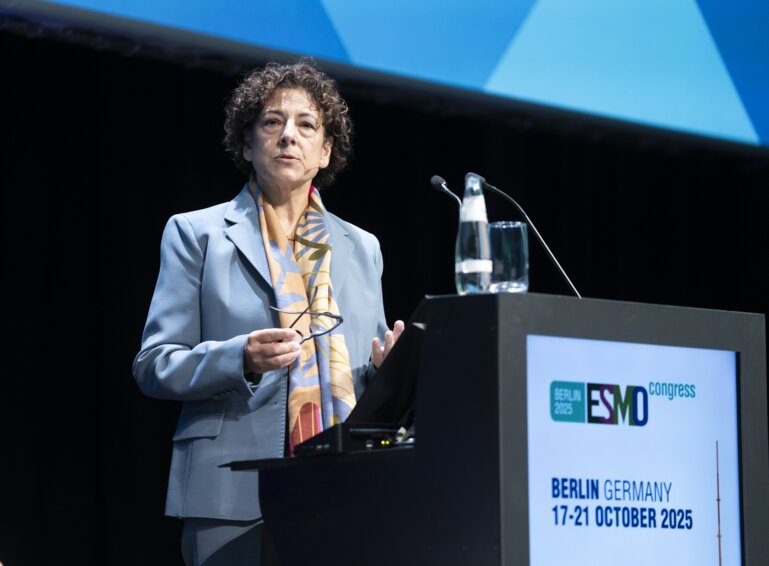Trastuzumab has transformed the prognosis for women with HER2+ breast cancer. On the occasion of the ESMO Breast Cancer Virtual Congress 2021, leading oncology experts recall with enthusiasm the pioneering work of researchers like José Baselga in this field and push for continuous research to investigate how to further improve the treatment of this cancer sub-type
HER2 positive (HER2+) breast cancer is an outstanding example of what can be achieved in oncology when you identify the Achilles heel of a tumour: adding trastuzumab to standard chemotherapy has transformed the prognosis for the one in seven women with this cancer subtype.
“It is unquestionably the breast cancer sub-type in which we have seen the biggest advances,” says Prof. Martine Piccart, Université Libre de Bruxelles and the Jules Bordet Institute, Brussels, Belgium, reflecting on the recent history of breast cancer research on the brink of the ESMO Breast Cancer Virtual Congress 2021 where further advances in the field will be presented. “We are now curing more women and we have markedly extended survival for those with advanced disease.”
The use of trastuzumab in combination with chemotherapy was initially approved for metastatic HER2+ breast cancer after it was shown to reduce mortality by 20% compared to chemotherapy alone (N Engl J Med. 2001 Mar 15;344(11):783-92). The subsequent HERA trial confirmed the survival benefits in early-stage disease (N Engl J Med. 2005 Oct 20;353(16):1659-72) and the 90% five-year survival for HER2+ breast cancer is now similar to that for hormone receptor positive (HR+) disease (National Cancer Institute 2021).
Despite the impact of trastuzumab, some women – particularly those with node positive disease – do less well, and research is focusing on combinations of anti-HER2+ therapies that can improve efficacy without exposing patients to unacceptable toxicity. These include a second HER2+ monoclonal antibody, pertuzumab, the anti-HER2 tyrosine kinase inhibitors, lapatinib, neratinib and tucatinib, and the antibody-drug conjugates, trastuzumab emtansine (T-DM1) and trastuzumab deruxtecan.
At this week’s ESMO Breast Cancer Virtual Congress 2021, a final analysis will be presented from the BERENICE safety trial which has addressed concerns that combining trastuzumab and pertuzumab with anthracyclines might exacerbate cardiotoxicity.
“BERENICE originally showed a very low incidence of heart problems in the neoadjuvant setting and this follow-up at five years has confirmed there was no increase in the adjuvant setting and the risk of cardiotoxicity is extremely low,” says lead investigator Dr Sandra Swain, Georgetown University Medical Center, Washington DC, USA. “What is also very exciting is that the pathological complete response rate was very high at around 60% and the event-free survival was around 90%.”
The BERENICE efficacy data support previous evidence of the survival advantages of pertuzumab and trastuzumab compared to trastuzumab from the CLEOPATRA trial in metastatic breast cancer (N Engl J Med. 2015 Feb 19;372(8):724-34), and the APHINITY trial in early breast cancer (N Engl J Med. 2017 Jul 13;377(2):122-131).
Baselga’s legacy to translational research
A key figure behind much of the pivotal early preclinical and clinical research on trastuzumab and subsequent anti-HER2+ therapies was ESMO Past President, José Baselga, who sadly passed away in March 2021. As Swain and Piccart point out, some trials including HERA and CLEOPATRA, might never have happened without his drive and commitment.
Since as early as 1991, Baselga strongly promoted a bench-to-bedside approach to expedite the development of cancer medicines, pioneering what is today called translational oncology and building the foundations for the birth of precision medicine. “He was a great collaborator, high energy and a true visionary in oncology. He was continually looking to make treatment better for patients. Good was never enough, he always wanted better,” Swain explains.
His pioneering work in HER2+ breast cancer led to the approval of trastuzumab, with a direct impact on how most women with this tumour subtype are still cured today.
Piccart, co-founder of the global Breast International Group (BIG) of academic research groups, greatly valued Baselga’s support and positivity when getting large collaborative trials off the ground and highlights his major contribution to the design of key studies that have shaped clinical practice.
“He was also a big supporter of women in oncology and he encouraged me to stand for the ESMO presidency in 2012. He was frustrated that there were so few women in leadership positions in Europe and really wanted that to change,” Piccart recalls.
Addressing the heterogeneity of HER2+ breast cancer
Ongoing translational research is aimed at understanding why some women respond better to HER2 targeted therapy than others. Piccart explains that tumours which express both HER2 and hormone (HR+) receptors are most complex: some are more HER2-dependent and best treated with anti-HER2 agents. Others are more HR-dependent and likely to require new approaches, such as anti-HER2 agents combined with CDK4/6 inhibitors, which are starting to be tested in patients with advanced HR+ HER2+ disease.
Another approach is to target the phosphoinositide 3-kinase (PI3K) mutations found in 30-40% of patients with HER2+ breast cancer. Although initial studies with pan-PI3K inhibitors proved disappointing with high toxicity, Piccart points out, results with newer more alpha-specific agents, such as alpelisib, are likely to generate better results.
We are still far from fully tailoring treatment to the characteristics of each tumour, but it is very exciting to be thinking about targeting multiple different pathways and possibly developing treatment combinations that can replace the need for chemotherapy.
A plethora of new antibody-drug conjugates
Both Piccart and Swain are very optimistic about the potential of the antibody-drug conjugates which use trastuzumab to deliver cytotoxic drugs to HER2+ breast cancer cells. In the EMILIA trial in patients with HER2+ advanced breast cancer previously treated with trastuzumab and taxane, T-DM1 significantly prolonged progression-free and overall survival with less toxicity than the combination of lapatinib and capecitabine (N Engl J Med. 2012;367:1783-91).
More recently, the antibody-drug conjugate, trastuzumab deruxtecan, which Swain explains has a higher drug-to-antibody ratio than T-DM1 (approximately 8 versus 3 to 4), has demonstrated promising results in patients with advanced HER2+ breast cancer who had previously been treated with T-DM1 (N Engl J Med. 2020 Feb 13;382(7):610-621).
“These results were really exciting because there was a 60% response in heavily pre-treated patients,” says Swain. “Further studies are recruiting, though there are concerns about interstitial lung disease reported in some patients treated with trastuzumab deruxtecan, and we need to see if that can be reduced, given that TDM-1 has minimal toxicity,” she adds.
Piccart explains that with so many antibody drug conjugates in development, each delivering a different cytotoxic agent, it is likely that patients will be treated with each agent sequentially depending on how their disease responds and recurs. She also points out that the nature of the link between trastuzumab and the cytotoxic agent – cleavable or non-cleavable – may be important.
“The advantage of a non-cleavable link, such as in TDM-1, is that you see very low toxicity – no alopecia and very little gastrointestinal toxicity. The newer agents have cleavable binding and may have so-called ‘bystander effects’ with higher efficacy including in tumours with low HER2 expression, but a side-effect profile more like traditional chemotherapy,” says Piccart.
Also arousing considerable interest is the HER2 TKI, tucatinib, which reduced the risk of intracranial progression or death by 68% when combined with trastuzumab and capecitabine, compared to trastuzumab and capecitabine and placebo. Median overall survival was 18 versus 12 months (J Clin Oncol. 2020 Aug 10;38(23):2610-2619).
“If this is confirmed in further studies of this and other combinations with tucatinib, this would be an exciting advance because brain metastases are one of the big gaps in treatment of HER2+ breast cancer,” says Swain.
More caution in de-escalating treatments
Treatment de-escalation is another priority for HER2+ breast cancer, especially to reduce the need for chemotherapy. Studies are establishing whether it is possible to reduce the need for anthracyclines in some chemotherapy regimens and carboplatin in others.
We know we have great efficacy with the newer anti-HER2 regimens so the trend now is to see whether we can achieve the same results with less chemotherapy drugs, for example carboplatin, and therefore decrease toxicity and improve quality of life.
Research is also investigating whether some low-risk patients, such as those with HR+ HER2+ breast cancer and negative lymph nodes may respond well to targeted anti-HER2 therapy without any chemotherapy.
As a result of the HERA trial (N Engl J Med. 2005 Oct 20;353(16):1659-72) which showed that one year of trastuzumab therapy was as effective as two years, standard treatment is already for the shorter time period. However, as Swain points out, an analysis of all relevant data is needed before duration can be reduced further – something that is planned by the Early Breast Cancer Trials Collaborative Group which she co-chairs.
Piccart also advises caution over de-escalation and explains that although pathological complete response (pCR) data from small studies are very promising, large collaborative, longer term trials are now needed in patients with low disease burden and negative nodes that can provide rapid results.
“We have made so much progress in HER2 positive breast cancer and are curing so many women it would be a total disaster if we found ourselves going backwards as a result of trying to de-escalate treatment inappropriately. We have a phenomenal range of drugs at our disposal and in development and, as we move forward, we need to be really smart in the way we use them alongside surgery, radiotherapy and chemotherapy,” concludes Piccart.








